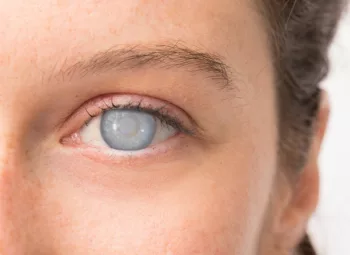Cataract surgery is an extremely common and successful eye surgery. Dr. Tandon, who leads NeoVision, has two decades of experience as an ophthalmologist, and has performed thousands of successful eye procedures for her 20,000 patients in the Bay Area.

What Causes a Cataract?
There are many possible causes of a cataract. The most common cause of cataracts is aging. According to the National Eye Institute, by age 80 more than half of all Americans either have a cataract or have had cataract surgery.
A cataract is a clouding of the normally clear lens of the eye. The clouding is created when the protein in the lens of your eye starts to clump together and cloud the lens. This clouding decreases the amount of light that is focused on the retina, resulting in blurred vision.
In addition to aging, cataracts can be caused by:
• Congenital Cataract: Some babies are born with cataracts or develop them in childhood, often in both eyes. These cataracts may not affect vision. If they do, they may need to be removed.
• Secondary Cataract: Cataracts are more likely to develop in people who have certain health problems, such as diabetes. Cataracts are also sometimes linked to medications such as steroid use or previous eye surgery.
• Traumatic Cataract: Cataracts can develop soon after an eye injury, or years later.
Other factors, like smoking, air pollution, heavy drinking, radiation, and certain medicines can also increase your chances of developing cataracts.
How Do You Treat a Cataract?
After your eye doctor has examined your eyes and found that you have a cataract, your doctor will help to determine if your vision can be corrected by glasses or cataracts.
When a cataract is small (i.e. cloudiness affecting only a small part of the lens), you may not notice any changes in your vision and it may not cause a problem. Stronger lighting, magnifying lenses, and eyeglasses may alleviate vision problems caused by early-stage cataracts. However, over time, the cataract may grow larger and cloud more of the lens, making it harder to see.
If your vision is being impeded by cataracts and cannot be corrected with glasses or contacts, your doctor might determine that cataract surgery is right for you. There are no medications, no eye drops, no exercises, or no glasses that will cause a cataract to disappear once it is formed. Surgery is truly the only remedy to remove a cataract that is impeding your vision and daily life.
How the Treatment Works:
Cataract surgery is a very common and highly successful procedure. Over 95% of patients experience improved vision after surgery. Cataract surgery is an outpatient procedure performed under local or topical anesthesia.
There are different types and techniques of cataract surgery available today. Traditional cataract surgery and the new laser-assisted advanced cataract surgery procedure.
Traditional cataract surgery consists of a surgeon making a medium-sized slit on the side of your cornea and removing the cloudy section of the lens in one piece. The opthamologist then vacuums out the rest of the lens. Basic cataract surgery patients may still need reading glasses after surgery.
Advanced laser-assisted cataract surgery consists of a small (only 2.8mm) cut made on the side of your cornea and a small instrument, called a phacoemulsification probe, inserted through this cut to emulsify and remove the cataract. The initial wound is self-sealing and no stitches are required to close the wound. Advanced cataract surgery patients have the advantage of having both distance and reading vision corrected.
Once your cataract is removed, your doctor will typically implant an intraocular lens (IOL) to replace the lens of your eye. An intraocular lens is a silicon or plastic lens that replaces the natural lens of the eye to restore vision after a cataract has been removed.
There are different types of IOL’s:
• MonoFocal IOL: Restores vision for one area of focus- usually distance. Reading glasses may still be needed with MonoFocal lenses.
• MultiFocal IOL: Allow for both distance and near vision correction. MultiFocal lenses are a new breakthrough that allows for the discontinued use of reading glasses.
• Toric IOL: Correct astigmatism as well as nearsightedness or farsightedness. These types of IOL’s can help to restore vision and negate the use of glasses for astigmatic cataract patients.
If you have cataracts in both eyes, your ophthalmologist will not remove them both at the same time. Each cataract will be removed separately with an interval of at least two weeks in between.
As with any surgery, there are risks with cataract surgery. These risks include bleeding and infection but are relatively rare. Your ophthalmologist will make great efforts to reduce the possibility of infection with topical antibiotic eye drops and aftercare instructions.
After Cataract Surgery: The Results & Aftercare:
Cataract surgery has relatively little downtime and you will be able to go home the same day as your procedure. You will need to ensure you have a ride home, as you will be unable to drive. Your vision will fully return in two to three days, so it’s advised to take it easy and take care of yourself during this period.
After your initial cataract surgery, you will be asked to avoid heavy lifting, bending or exercise for 2 weeks. You will be asked to use some eye drops in the operated eye. As previously mentioned, these eye drops will help to reduce your risk of infection and ensure proper healing.
Your eye will be examined very frequently during the post-surgery period. The first follow-up appointment is generally at a week after your surgery and then again at the four to six-week marks. If you need another cataract removed, you will be able to have surgery on the second after the first corrected eye is healed.
About NeoVision EyeCenter:
By providing our patients with the latest technologies we are able to give our patients the best possible post-surgery vision available today. Most vision centers perform traditional cataract surgery, which leaves many patients still needing reading glasses after surgery. Stanford-trained Ophthalmologist Dr. Shobha Tandon has decades of experience practicing cutting-edge cataract removal techniques and is happy to offer her patients the most advanced cataract surgery available today.
With NeoVision, better vision is within sight: Schedule your free consultation at one of our locations today.
Sources:
https://www.nei.nih.gov/learn-about-eye-health/eye-conditions-and-diseases/cataracts
https://www.webmd.com/eye-health/cataracts/what-to-expect-from-cataract-surgery
https://www.djo.harvard.edu/site.php?url=/patients/pi/408





